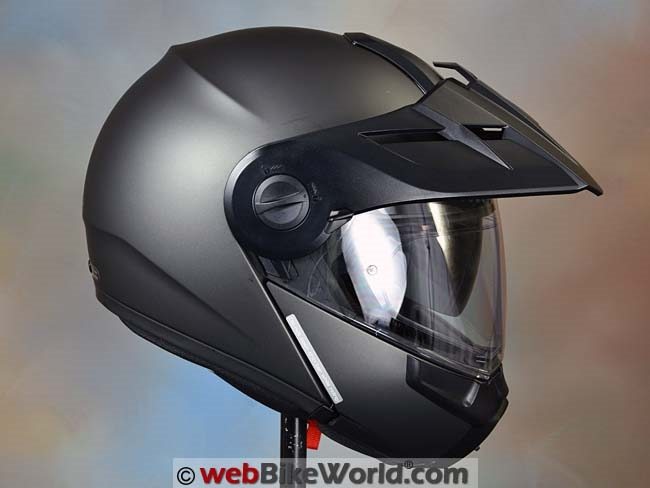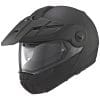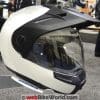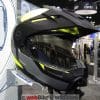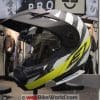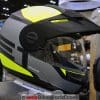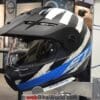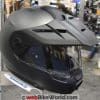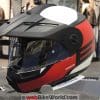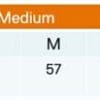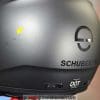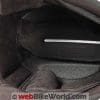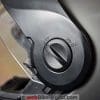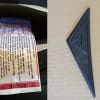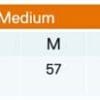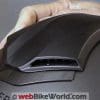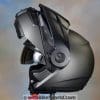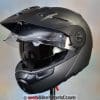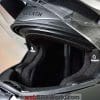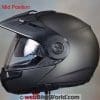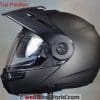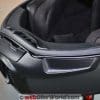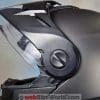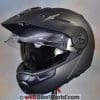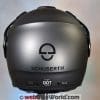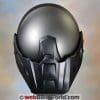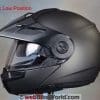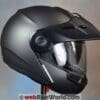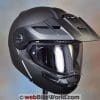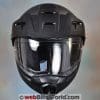The SCHUBERTH E1 was announced at the 2015 AIMExpo (Report) and described in our SCHUBERTH E1 Preview. Just for the record, the E1 isn’t the first flip-up dual-sport helmet; that award goes to the Caberg Tourmax (review), released in 2013. The E1 is basically a variant of the SCHUBERTH C3 Pro (review), with additional features and a few updates.
But one thing’s for sure: the E1 feels solid as a rock. You won’t know it’s a flip-up once you secure and dog the hatch. The E1 comes with an installed Pinlock-type anti-fog insert on a face shield and eye port that provides excellent visibility. The easily removable peak isn’t as stiff as we’d like, however; it can vibrate at speed, especially in turbulence and it generates noise.
The new dual chin vent system provides excellent ventilation, as long as you’re riding sans windscreen. The top vent isn’t quite as effective and it can be slightly balky to operate. It would be much more effective if the helmet had a traditional exhaust vent.
And the E1 is also antenna-ready for the SCHUBERTH SRC intercom system (review).
The incremental improvements and C3 “lessons learned” means that the E1 is the most solid-feeling helmet in the C3 range. And by the way, you can easily remove the peak and have a C3 with better ventilation, so it’s kind of a two-for-one. In fact, if you’re in the market for a C3/Pro, don’t overlook the E1, even if you’re not looking for a dual-sport helmet.
As a side note, SCHUBERTH has also partnered with Touratech to make another C3/E1 variant, the Touratech Aventuro Mod (Preview). We have one in the review process as this is being written, so be sure to check back soon for the full review of the Aventuro Mod and a comparison with the SCHUBERTH E1.
See Also: Helmet Buyers Guide, Helmet Review Home and all Schuberth Helmet Reviews.
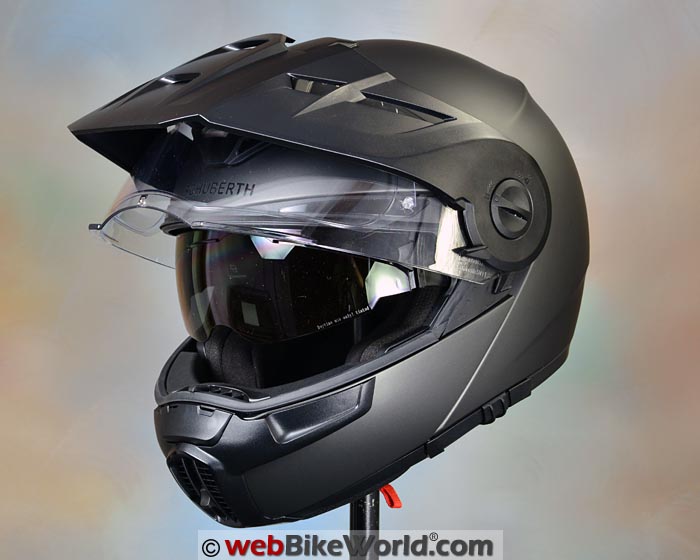
Background
Thank goodness for the dual-sport market for motorcycles and gear! If it wasn’t for that, worldwide motorcycle sales would probably be even weaker than they are now.
In fact, some might argue that dual-sport and adventure-touring has done for motorcycles what mountain bikes did for bicycles: revitalized the industry.
Dual-sport helmets (off-road helmets with a face shield) are now ubiquitous, to use a $5.00 word. But SCHUBERTH is known for flip-ups.
What to do?
How about the SCHUBERTH E1, a dual-sport flip-up mashup, which was introduced at the 2015 AIMExpo (Report) and described in our SCHUBERTH E1 Preview.
In fact, now that you think about it, why did it take SCHUBERTH so long to jump on the dual-sport bandwagon? After all, their fellow citizens at BMW started the whole dual-sport thing back in 1980.
Throwing a peak on a C3 or C2 or Concept should have been a no-brainer. Of course, hindsight is 20/20, as they say. And riders would have balked at a flip-up with a peak back around 10 years ago or so.
It took tiny Caberg to beat everyone to the punch in 2013, when they released the Caberg Tourmax (review). Flip-up dual-sport helmets are still rare as hen’s teeth, but Scorpion just announced the Scorpion AT950 flip-up dual-sport helmet with a list price of $269.50.
We’ll have a review of that one soon also.
So maybe dual-sport flip-ups will actually become a thing? Why you’d want a flip-up with a peak is still the question, but nevertheless, the movement is apparently here.
Our only wish is that SCHUBERTH would have used a brand-new shell for the E1. To be frank, the C3 series is showing its age and we’re hoping for a C4.
SCHUBERTH doesn’t release new helmets very often, but they did it to enter the open-face market, with the SCHUBERTH M1 (review). Its modern design earned it a webBikeWorld Motorcycle Helmet of the Year Award in 2015.
In any case, the E1 may be the last variant of the C3, as SCHUBERTH is planning a big announcement this fall. We’re hoping it’s the C4, with more than two shell sizes to span the head size range…
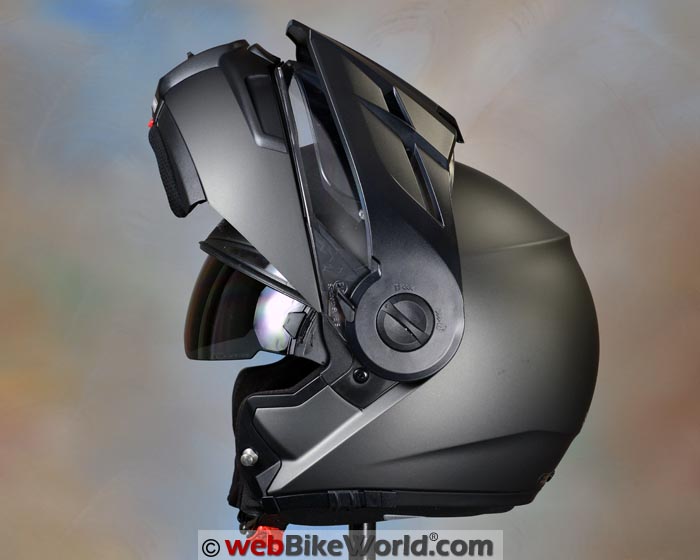
SCHUBERTH E1 Paint, Graphics and Overall Quality
Our E1 shown here is in the “Anthracite” matte gray color. Solid colors also include white, silver, black (gloss and matte) and there are two graphic designs with brighter colors, the “Guardian” and the “Hunter”.
The E1 in the “Guardian” graphics (red or yellow) is the E1 to get in our opinion, although it will cost you an extra 70 bucks. There’s also a “Hunter” graphic in red, yellow or blue accents.
Both of these graphics and the colors are illustrated in our SCHUBERTH E1 Preview.
Fire up your E1!
The E1’s peak is plastic and it’s very easy to remove.
So just rough up the surface a bit, spray on some primer and then get a can of spray paint.
High-viz yellow, orange, red, white, gold, Hammertone…whatever your heart desires. Then spray away!
You’ll have instant cheap personalized color and get some good visibility at the same time.
In fact, we fully expect to see E1 peaks in all sorts of color schemes painted by owners.
SCHUBERTH should market this capability as a selling point!
Normally, a garage paint job on a helmet shell is not recommended, but there’s no problem painting the peak.
What could happen? Don’t like the color? Change it!
Anyway, the matte Anthracite on our E1 is perfectly applied.
So we have no issues to report at all.
There is one thing to know about the half-matte surface finish though.
It shows scuff marks pretty quickly and easily, so take a little extra care.
Our helmet became scuffed the first time we removed the peak and it rubbed against the side of the helmet, as you can see in the photo below.
Not to worry — the build quality of the E1 is outstanding.
In fact, each time we have reviewed a C3 variant, the build quality gets better.
It’s ironic (or maybe not) that what may be the last of the C3 variants has the best build quality of all.
This one has none of the loose liner bits or chin curtain issues we found on the C3 and C3 Pro (review).
The liner and fabric appears to be new for the E1 and it has a nicer, more rugged material used along the outward-facing bottom part of the neck roll.
And the E1’s liner fabric even feels more comfortable than the C3.
The only carryover C3 issue is the rotating flip-up visor locking mechanism, which still isn’t as solid as we’d like.
As we found on the C3 and C3 Pro, it’s hard to tell if and when the rotating flip-up visor is actually locked when it’s closed, because there’s no solid “click” sound.
You have to slam the visor home, then hold the helmet in the rear and push on the front, then check to confirm that it’s actually locked.
Otherwise, once the hatch is battened down, the E1 feels for all intents and purposes like a one-piece full-face helmet. And that’s good.
Score: The SCHUBERTH E1 has outstanding quality all around, in both design and execution.
SCHUBERTH E1 Helmet Fit, Internal Shape and Liner
It sure feels like the internal shape of the E1 has been relaxed just a touch, pushing the E1 more towards “Neutral” than the “Narrow” shape used in the past.
Maybe it’s a different type of fabric, but the E1 in both the L and XL sizes feels slightly less narrow than the C3 or C3 Pro we have on hand.
In case you’re wondering, that’s a good thing!
I (Rick) can’t wear a C3 or C3 Pro in size L because it’s too narrow for my “Earth” shaped head (widest in the middle). Yet I’ve worn the E1 in size L, even with my eyeglasses, with no problems. It’s tight, but it works.
The XL has slightly more room fore and aft on top, as expected, but it still fits my round head very nicely.
Bottom line: we’ll still call this a “Slightly Narrow” shape but if you’re a round head that hasn’t been able to fit a C3 before, try the E1, maybe it’s just different enough that it might fit.
Otherwise, the liner quality and the way it’s installed is improved over the C3 and C3 Pro. Several years’ experience has paid off, apparently.
There’s none of that “I can feel the EPS” sensation either with the E1 — no hard points inside, so maybe the padding is thicker or maybe it’s now designed to cushion the corners?
We tried to get some guidance on this from SCHUBERTH but they seemed reluctant to answer.
The marketing documentation does have this statement, however:
“A special inner lining of the E1 has been developed according to the innovative Comfort Fit concept. It ensures that the helmet fits comfortably and securely in all situations.
The combination of carefully selected COOLMAX and Thermocool materials and the additional use of Interpower coatings also make the inner lining a highly effective moisture removal and cooling system.”

Shell Sizes and Fit
OK, we’ve mentioned this a couple of times but it’s important to note that the C3, C3 Pro — and the E1– have just two shell sizes to cover the entire size range.
The shell size change comes after head size L (59 cm) and this creates a non-standard head sizing scheme for the C3, C3 Pro and now the E1.
As you can see on Schuberth’s sizing chart above, there is a big jump from 59 cm to 61 cm when going from the L to XL sizes.
Usually, a size L is 58-59 (or 59-60) and the XL a 60-61 (or 61-62) in something like HJC and (Arai). However, our size large is labeled 59 cm and that seems exactly correct, so apparently Schuberth’s sizing chart can be trusted.
With the C3, the size L can be too small and the XL too big. We have received several emails about this from webBikeWorld readers.
The E1 seems to be more lenient about this than the C3; we think the former fits more like the size large open-face M1, which we said “moves the indicator very slightly towards the ‘Neutral’ category but it’s still a ‘Slightly Narrow’ profile.”
The thick and cushy padding in the M1 (and possibly the more flexible open-face shell) helps to mask the shape and fit slightly.
We’d be remiss not to kvetch about this as an issue with an $800.00 plus helmet.
If Scorpion can offer 3 shell sizes in the $209.95 list price Scorpion T510 (review) and yes — 3 shell sizes also in the new AT950 dual-sport flip-up, then SCHUBERTH needs at least 3, if not 4 or 5 shells for the high-buck E1.
Bottom line: As with the M1, the E1 has a “Slightly Narrow” to “Neutral” internal shape that seems a tiny bit relaxed compared to a size large C3.

More information on helmet fit can be found in the webBikeWorld Motorcycle Helmet FAQ page.
Also reference the chart that lists the helmet weights of webBikeWorld reviewed helmets and also by shape on the webBikeWorld Motorcycle Helmet Shapes page.
Score: The E1 gets an “Excellent” rating for fit with a thicker and nicer-feeling liner than the current C3. See the helmet rating scale in the summary table below.
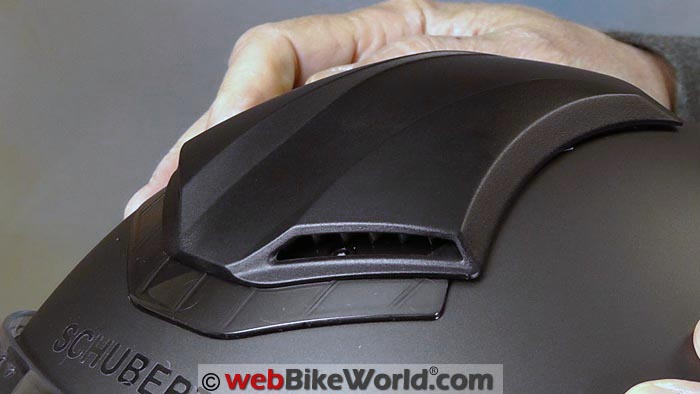
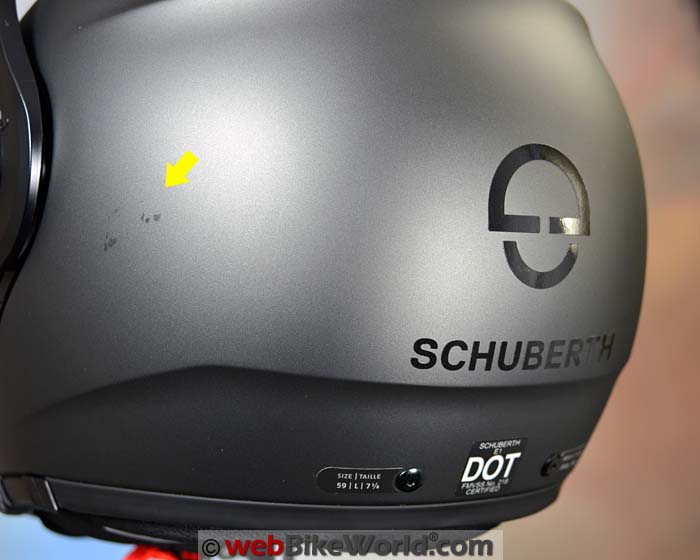
SCHUBERTH E1 Face Shield, Eye Port and Visibility
The E1 face shield is similar in shape and size to the unit on the C3 Pro, but the E1 has the special retaining system that attaches the peak.
The E1 also comes with a pair of round disks in the box that can be fitted to the E1 if the peak is removed and you want to wear the helmet without it.
The disks on the peak stay put but the convertible disks are separate, so don’t lose them!
The E1 eye port provides excellent visibility that’s nearly unlimited horizontal sight lines. You have to really bend your eyes to either side to see the edge of the eye port at the shell.
Vertical sight planes are very good also and the optical quality of the E1 face shield is outstanding. It measured 2.08 mm thick on ours.
The face shield includes the SCHUBERTH “turbulators” along the top which are designed to help break up the air stream and improve aerodynamics.
In what has become a SCHUBERTH standard, the face shield also has dual lift tabs, one on each side. The face shield seals tightly across the gasket along the top of the brow, which means it passes the webBikeWorld water ingress test (we tried it).
There’s a click-lock at the center, so the face shield can be “locked” to keep it closed or you can rest it on top of the detent for some city defogging.
Internal Sun Visor
The internal sun visor operates with a slider on the lower left of the helmet shell. The sun visor provides outstanding coverage with the same high-quality optics as the clear face shield. Both are available in an assortment of tints, by the way.
The internal sun visor can also be stopped in an intermediate position, another plus.
Pinlock Equipped?
The E1 face shield is equipped with a SCHUBERTH anti-fog insert. That’s a nice touch although the outer edges of the Pinlock are visible in the rider’s line of sight.
UPDATE: SCHUBERTH told us that SCHUBERTH is no longer using Pinlock, as the Pinlock patent has now expired.
“We have our own anti-fog lens installed on the E1 and also all other SCHUBERTH helmets will have SCHUBERTH Anti-Fog lenses going forward”, according to Schuberth.
The Peak
Part of the definition of a dual-sport helmet is the peak. No one really seems to know why off-road or motocross helmets have a peak; we’ve heard a number of explanations (“Keeps the mud off”) but none make sense.
Will the inventor please step forward?
In any case, the peak on the E1 is easily removable by a quarter-twist of the attachment disks. But it has a nice trick: it adjusts to one of 3 positions (low, mid and high) and locks in position via levers on either side.
In the lowest and middle positions, the peak does an excellent job of blocking the overhead sun and, in fact, that is its most effect and primary purpose.
Unfortunately, the plastic material SCHUBERTH used seems thin and this makes the peak feel a bit flimsy and not up to the Gibraltar-like solidity of the rest of the E1.
In fact, the peak can vibrate and shake when you’re riding, especially if there’s turbulence coming off a windscreen and directed along the top of the helmet.
We’d suggest that SCHUBERTH do some Finite Element Analysis (FEA) on the peak and maybe develop a stiffer version.
The peak also adds to the E1’s noise levels.
We experimented with different air positions when riding different motorcycles and turbulence — especially from a windscreen like you’d find on the type of dual-sport or adventure-touring bike expected to be owned by E1 customers — causes added noise.

Score: The SCHUBERTH E1 rates an “Excellent” for the design and operation of the face shield and sun visor.
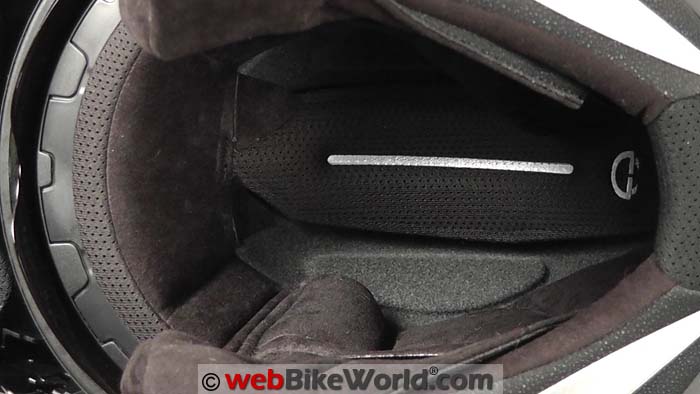
SCHUBERTH E1 Ventilation
Probably the most significant difference between the E1 and the C3/Pro is the new dual chin vent system on the former.
The top half (or 1/3) of the chin vent operates like the C3 series, with the rocker moving the top of the vent open but not facing directly into the air stream.
The new bottom half (2/3?) is a large off-road style vent with a slider in the center. It moves air directly through the chin bar and then through a foam filter that is easily removable on the inside of the chin bar.
This provides excellent ventilation as long as you’re not riding behind a windscreen. Obviously, any windscreen that blocks air to the lower half of the helmet will affect the amount of air flowing through a helmet chin vent.
The top vent is similar to the C3 Pro, with a large sliding wedge-shaped section that moves through two detents.
Top Vent Notes
The air flow through the top vent is actually pretty good — just remember to fold the two flaps inside so they are not blocking the vent holes!
Many owners don’t realize that SCHUBERTH adds these flaps in the C3 system which cover the holes in the default position.
They’re apparently designed for winter use but you’re better off simply cutting them off because they only get in the way and have a habit of moving out and covering the vent holes.
However, we still think the C3/Pro shell design needs a “traditional” rear exhaust vent located on the upper part of the rear of the shell to pull air through.
Apparently SCHUBERTH decided that a traditional rear exhaust would add to the noise levels but this simply isn’t true in our experience. With a proper design, a rear exhaust doesn’t necessarily add noise.
(UPDATE: In fact, the Touratech Aventuro Mod, made by SCHUBERTH for Touratech and also based on the C3 Pro/E1, does have exhaust vents at the upper rear. It also includes a goggle strap. Full review is in process.)
Bottom line here is that the ventilation system is better than the C3 or C3 Pro, so again, if you’re looking at a C3, you may want to consider the E1 with its removable peak.

Score: The SCHUBERTH E1 gets an “Excellent” rating for ventilation.
SCHUBERTH SRC
The neck roll SCHUBERTH SRC Bluetooth intercom (review) system is made by Cardo for SCHUBERTH. The E1 has an antenna installed in the shell and it’s ready for the SRC system, which has a list price of $399.00.
Note that not all of the SCHUBERTH SRC systems will pair with other brands of intercoms, so check this first. You can install other brands of intercom systems on the C3, C3 Pro or E1 but you won’t be able to use the internal E1 antenna.
SCHUBERTH E1 Sound Levels
The SCHUBERTH E1 isn’t as quiet in as many varied conditions as we’d hoped, but neither is the C3 or C3 Pro. On the E1, the peak and the protruding top vent assembly create wind noise, especially in turbulent air.
But if your windscreen directs the air so that it does not focus on the helmet, then the E1 is very quiet.
In the open air — as on an unfaired motorcycle — the E1 is about average for noise control. Again, the peak and top vent add some wind noise and if you place your hand in front to block the air, the noise levels decrease dramatically.
Overall, the noise levels are about average for a flip-up helmet unless you’re riding behind a big windscreen, then the E1 is very quiet.

Note that our helmet evaluations are a combined effort of several riders over time on different types of motorcycles with and without windscreens.
Evaluators wear correctly fitted, high quality ear plugs (even when evaluating motorcycle intercom systems).
Always protect your hearing when riding a motorcycle. See the wBW Earplug Reviews for more information on choosing and wearing earplugs.
Note also that perceived noise levels will vary, depending on the individual.
Noise can be caused by many factors, including helmet fit, the type of motorcycle and windscreen, wind speed and direction and even the rider’s clothing.
For more information on helmet noise, visit the wBW Motorcycle Helmet Noise page.
Score: We’ll give the SCHUBERTH E1 a “Very Good” rating for noise control.
wBW Video: SCHUBERTH E1 Helmet
SCHUBERTH E1 Helmet Weight
This E1 helmet in size large weighs 1803 grams (3 lbs., 15-5/8 oz.), which is relatively heavy.
This is a little surprising actually, as our SCHUBERTH C3 (review) in size XL weighed 1709 grams and the SCHUBERTH C3 (review) in size L weighed 1692 grams.
Our SCHUBERTH C3 Pro (review) in size XL was heavier, at 1798 grams.
Apparently the extra weight of the E1 comes from the addition of the peak and the new “nose” on the dual-sport E1. However, the snug fit of the E1 and good aerodynamics masks the weight, more or less.
All of these weights for full-face, flip-up and open-face helmets are available on the wBWMotorcycle Helmet Weights page.
Also see the chart that lists the helmets by weight and shape on the wBW Motorcycle Helmet Shapes page.
Score: The SCHUBERTH E1 gets a “Neutral” rating for its weight but with excellent balance.
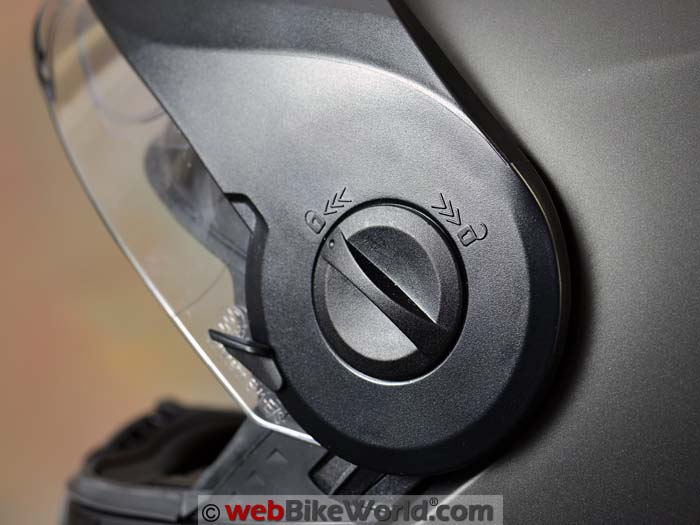

Goggles?
Some owners have raised the issue of fitting goggles with the E1. There is no goggle strap in the rear, nor is the C3/Pro helmet shell designed to fit a goggle strap.
Also, the eye port design is not conducive to fitting a goggle strap.
But here’s the issue: who’s going to wear goggles with a flip-up dual-sport helmet? If you really need goggles, get a true off-road helmet. It’s hard to imagine one rider in 1,000 wanting to fit goggles to an E1, so this is a non-issue.
Miscellaneous
The E1 has the love-it-or-hate-it “quick release” micro-adjust style chin strap buckle fitted by SCHUBERTH that’s typically thick and a bit clunky.
Some owners can not wear a C3/Pro because of this but actually, it doesn’t bother us really. To help, the chin straps are nice and thick and provide full coverage.
The E1 meets the DOT standard in the U.S. and the ECE standard in Europe. It has a five year warranty in the U.S. and 2 years in Germany.
- Outstanding build quality.
- Chin vent system.
- Good sun visor coverage.
- Solid feel.
- Adjustable peak.
- SRC system available.
- Price, price, price.
- Only 2 shell sizes.
- Noise.
- Flimsy peak.
- Needs better exhaust.
- C3 design showing its age.
Conclusion
The SCHUBERTH E1 is sort of a touring helmet with an adventure-touring “lite” bias. It’s not a full-on dual-sport helmet by any means and if you accept that up front, you’ll better understand the helmet. It has a very solid feel and build and it’s obvious to us, after reviewing SCHUBERTH helmets since long before they were even available in the U.S., that the company has made incremental improvements in the design and construction.
The E1 is even a good replacement for the C3 or C3 Pro, since the peak can be easily removed if desired. That E1 should be very popular with SCHUBERTH fans but just remember that it’s biased more towards casual adventuring rather than real off-roading.
Then we get to the cost. At $829.00 for the solid colors and $889.00 for the graphics, it’s a lot of money. Again, die-hard SCHUBERTH fans will shrug it off but new-to-the-fold customers may gasp at the price. The flip side — if you can stand a final pun — is that the E1 has to be one of, if not the most solidly built flip-up motorcycle helmets you can buy today.
Owner Comments and Feedback
See details on submitting comments.
From “R” (June 2016): “Thanks for your reviews, very helpful. Just a quick comment on the SCHUBERTH E1. I have a plain white E1, European ECE compliant, not DOT/Snell/AS, that may make a difference.
Your article state weight 1803 grams, here are my weights (weight on kitchen digital scales):
- SCHUBERTH E1 without shield: 1592 g
- SCHUBERTH E1 with shield: 1720 g
- For Comparison: Bell RS-1 with Bluetooth: 1872 g
Editor’s Note: Just for the record, the SCHUBERTH E1 in the U.S. meets the DOT standard only, it isn’t Snell certified.
Follow-up From “E.L.” (June 2016): “The E1 came yesterday, props to RevZilla, the order was filled Monday, got it Wednesday. I bought the flat black version to go with my bike’s black denim paint.
Took it for a spin on my ’09 FLHT this evening, with the sun beating down in the evening sky. The ride was about an hour or so, some city streets, country roads, a bit of twisties of the Kettle Moraine Scenic Drive and a good blast down the highway.
I rode into and away from the sun as well as across it.
I bought this helmet mostly because of my experience with the first SCHUBERTH flip front and because the visor would hopefully help me avoid blinding glare. It mostly worked well there were some things I liked, some I didn’t, and a few things were just odd.
Upon opening the box, I found an odd little plastic triangle floating in the bottom of the box (photo below). It looked to be made of the same stuff as the plastic bits of the helmet, but I couldn’t see anything that looked missing.
There was also a baggie with the two extra pivots and the biggest helmet instruction manual I’ve ever seen. The helmet itself came in a rather nice drawstring bag padded with some sort of batting.
The instruction manual was fairly straightforward, fairly easy to understand, although some of the drawings were cluttered.
The first off thing: the manual referred to warranty service through either SCHUBERTH or Intersport Fashions West, which was the original importer of the Schuberths into the US. I got my first one at an MSF conference straight from Paul Dean.
But Intersport went out of business in 2010 I’d thought and could find nothing on Google that was current.
Something I didn’t really care for was the monster warnings and manufacture date stamp label. See the photo. This was a bit over the top. I stuffed it into the lining best I could.
As were the originals, these run a bit small. My head measures as an XL, but I ordered a 2XL, because that’s what fit with my first SCHUBERTH. It did fit, nice and snug, not too tight, not binding.
The manual said that the chin padding should fit under the strap with a Velcro patch. My example had no Velcro there. I kind of liked the quick release feature. It didn’t try to snag my skin when being buckled like the old style. We’ll call that a plus.
The manual says to lock the chin bar in place with one hand. I found I needed two hands, one on the chin bar, the other on the back of the helmet to do it comfortably.
The main shield has several positions: closed, #1 slightly open, #2 open a bit more — this one holds the shield in place pretty well with friction, a #3 open more, less friction holding it in place, and fully open.
The visor has a neat little locking mechanism to hold it in pace, and three positions. I used the lowest position. I left with the visor in the #2 position, also wearing a pair of safety-rated polarized prescription sunglasses.
Once I got going, I closed the shield all the way, but found — as the manual suggested I would — that behind my bagger’s windshield I’d experience some fogging, so I left it in either the #1 or #2 position.
Looking through my polarized sunglasses and the main shield, I experienced a sort of color shift, probably due to my glasses and the two layer main shield.
Every car coming towards me, and cars parked in lots off the side of the road, all now sported green windshields. When I switched to my regular glasses, this no longer occurred.
I used the inner visor a few times and liked that it stays in pace where you put it, no preselected detents, that’s an important comfort consideration and another reason to pick one of these over another brand.
The visor started doing a little shimmy at about 40 MPH. This was likely from my windshield.
The wind blast hit the very top of the visor. A bit nettlesome, but not really annoying until about 75 or 80 on the freeway. I think that this is likely because the visor is only attached to anything at its ends, that’s a lot of free area for this rather flimsy piece.
Again, the manual did say I’d probably experience this. We’ll see how it feels after a few hundred miles in the saddle.
The visor did do its work well. Going into the sun, I just needed to tilt my head down for glare relief. Going across the path of the rays, I could tilt my head a little and get some shading. That’s what I bought this for.
One thing I did not like: At several T intersections, wearing my regular prescription wire framed glasses, when I turned my head, the glasses did not completely follow my eyes.
The helmet is very tight against the temples and this prevented comfortable movement of the glasses across the full range of view.
The helmet did remain comfortable for the entire ride with just one pressure point at the very back of my crown. This is probably my own pointy head, I’d expect this to ease as i break this lid in.
I didn’t notice any ventilation affect from the helmet’s ducting, but I was sitting behind a batwing fairing with the stock windshield.
For the last few city blocks home, I rode with the chin bar open. I know the manufacturer doesn’t want you to do that. But I know I’ve been doing it at slow speeds on occasion ever since I got my first one. Friction held the chin bar in the fully open position.
So, I’ll give it a 4 out of five right now. It is comfortable, its not too heavy, everything pretty much works as the manufacturer says it would.
I look forward to giving it a good workout over the summer.”
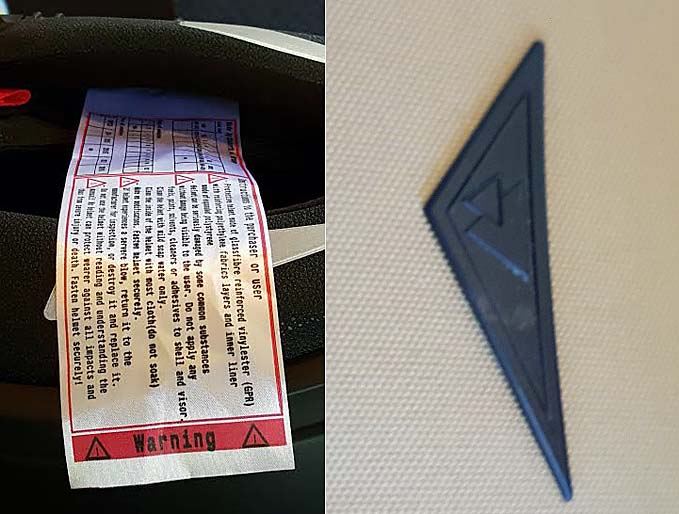


From “E.L.” (June 2016): “I owned one of the original C1s, best helmet I’d ever had to that point and after.
I’ve been shopping for a new lid to replace one gone past replacement timing, but have been unable to find something that could accommodate my 2X head with any real comfort like I had with the old C1.
So after having been on the fence with this for a while (due to the cost), I used your link and took the plunge.
This will be used to tour mostly on my ’09 FLHT. The bike is painted black denim, so I got the flat black lid. I wanted the peak along with the rest of the SCHUBERTH accoutrements, even though I don’t own a DS or ADV Bike.
I have a minor cataract in one eye and a plastic lens in the other eye from cataract surgery some years ago. The glare from the sun, even with sunglasses and the internal dark tinted shield on my current lid just could never overcome the sun’s early morning or late afternoon glare.
Additionally, a former colleague who road tested street bikes for a “major motorcycle manufacturer” always used an MX style lid to combat glare and having a peak was very helpful and worked for him.
The noise issue you cited appeared to be minor, since I’ve a touring windshield in front of me, I generally ride with my outer shields open a bit and wear safety rated prescription glasses and ear protection.
This does look like what I’ve been looking for. The ability to partly lower the inner visor is a real plus, and a flip-up chin bar works best for my bespectacled self. I’ll let you know how this one works out. Thanks for the useful review!”
From “S.E.” (June 2016): “The Touratech (Aventuro Mod) is basically a C3 Pro, the best helmet I have ever worn. Although I also own a SR1 for the hot days.
The Touratech “C3 Pro” seems to have ventilation vents just above the rear spoiler. Are those actual vent openings or are they just for show? I would love the have A C3 Pro with a bit more ventilation.”
Rick’s Reply: Yes, the exhaust vents on the Touratech Aventuro Mod version of the SCHUBERTH E1 has functional rear exhaust vents along the upper part of the helmet shell. It also has a goggle strap. Review coming soon.


